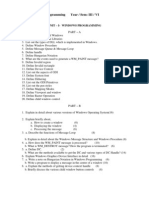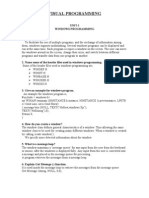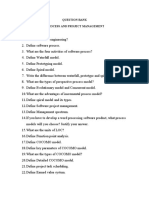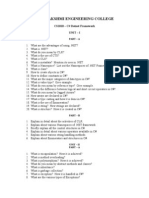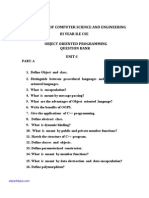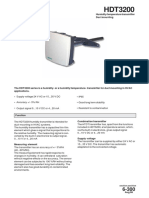0 ratings0% found this document useful (0 votes)
2K viewsCS1253 - Visual Programming
This document contains question bank for the subject Visual Programming with questions divided into two parts:
Part A contains short answer questions related to topics like Windows programming, Visual C++ programming, Document View architecture, ActiveX and OLE.
Part B contains longer answer/descriptive questions on the same topics asking to discuss, explain or provide programs related to concepts like Windows messaging, creating windows, MFC classes, document view architecture, ActiveX controls etc.
The document covers four units - Windows programming, Visual C++ programming, Document View architecture and ActiveX & OLE with questions aimed at testing knowledge of the key concepts and ability to apply them to write simple programs.
Uploaded by
KodaikdCopyright
© Attribution Non-Commercial (BY-NC)
Available Formats
Download as TXT, PDF, TXT or read online on Scribd
0 ratings0% found this document useful (0 votes)
2K viewsCS1253 - Visual Programming
This document contains question bank for the subject Visual Programming with questions divided into two parts:
Part A contains short answer questions related to topics like Windows programming, Visual C++ programming, Document View architecture, ActiveX and OLE.
Part B contains longer answer/descriptive questions on the same topics asking to discuss, explain or provide programs related to concepts like Windows messaging, creating windows, MFC classes, document view architecture, ActiveX controls etc.
The document covers four units - Windows programming, Visual C++ programming, Document View architecture and ActiveX & OLE with questions aimed at testing knowledge of the key concepts and ability to apply them to write simple programs.
Uploaded by
KodaikdCopyright
© Attribution Non-Commercial (BY-NC)
Available Formats
Download as TXT, PDF, TXT or read online on Scribd
You are on page 1/ 3
QUESTION BANK
SUB CODE: CS1253
SUB NAME: VISUAL PROGRAMMING YEAR/SEM: III/VI
UNIT – I
WINDOWS PROGRAMMING
Part-A (2-MARKS)
1. Write a simple windows program to print “Hello world”.
2. Define and list down the GDI Primitives
3. What is a message?
4. What is a message loop?
5. Define device context?
6. Under what circumstances painting is needed?
7. What are GDI primitives?
8. What are the ways to trigger WM-PAINT message? What does the message do?
9. What is a window programming?
10. List out the main header files in Windows programming
11. What is Hungarian Notation?
12. What are the steps required to create a window?
13. How to register a window class?
14. What is a window class?
15. How to create a window?
16. What is the use of Get Message ( )?
17. What are the actions of windows procedure?
18. What is WM_DESTROY message?
19. Which function is used to terminate the program?
20. What are the fields in MSG structure?
21. What are queued Message and Non queued Message?
22. Give some messages used in Windows
Part-B (16-MARKS)
1. Discuss on Windows Messaging.
2. Explain the VC++ components in detail
3. Explain briefly how to create, display and process the window with necessary
program.
4. Explain in detail about the windows message structure and windows procedure
5. Explain the various methods available to get the DC Handle
6. Explain windows GDI in detail
7. Explain GDI Functions and GDI Primitives
UNIT-II
VISUAL C++ PROGRAMMING – INTRODUCTION
Part-A (2-MARKS)
1. Give any four pen styles.
2. Give the default font, pen brush, bitmap.
3. What is appwizard?
4. What is class wizard?
5. What are accelerators?
6. What are the types of dialogs? Give application for each.
7. What is event driven programming?
8. Define Application Framework
9. What are the types of mapping modes?
10. What is the use of SetMapMode command?
11. List out the types of video cards used to display the colors
12. What is resole font?
13. What is the use of GetSystemMetrics function?
14. Differentiate CClientDC and CWindowDC
15. Differentiate Modal and Modeless dialogs
16. What is system modal dialog?
17. List some of the COMDLG32 classes?
18. What are dialog controls?
19. Mention some of the window common controls
20. What are keyboard accelerators? What are the messages generated?
21. What are the types of messages generated by mouse?
Part-B (16-MARKS)
1. Explain MFC Classes
2. Define keyboard Accelerators. Explain the purpose of keyboard Accelerators.
3. Explain Modal and Modeless Dialog with Example
4. Explain window common controls.
5. Explain in detail how you will load a bitmap into your application.
6. Explain the steps with an example for programming a model dialog.
7. Explain the different mapping modes. Compare and construct.
8. Write a program using VC++ to display the character pressed.
9. Write a program using VC++ to display mouse coordinates.
UNIT-III
THE DOCUMENT AND VIEW ARCHITECTURE
Part-A (2-MARKS)
1. What are toolbars?
2. What are the applications of multiple views?
3. Give two examples for MDI. How many child and parent windows are available in
MDI
program
4. What do DLL contain?
5. What is a serialize function?
6. What is a menu? What are its types?
7. Mention two text editing tools
8. What are the characteristics of SDI frame window?
9. What are the two CFrameWnd member functions?
10. How to make a class serialize?
11. Explain splitter window
12. Differentiate Dynamic and static splitter window
13. What are the functions that treat registry data as either CString objects or
unsigned
integers?
14. Define DLL
15. Explain document view architecture.
16. What is a view?
17. Differentiate SDI and MDI
18. What are the disadvantages of using DLL
19. What is Load Library ( ) function?
20. What is GetProcAddress ( ) function?
Part-B (16-MARKS)
1. Write a VC++ program to create a menu bar
2. Write a VC++ program to create a Toolbar
3. Write a VC++ program to create a status bar
4. Write a VC++ program to implement DLL
5. Explain SDI and MDI Applications in detail.
6. Differentiate Extension DLL and Regular DLL
7. What is meant by splitter window? How to create dynamic splitter window?
Implement a
dynamic splitter window in an MFC Application.
8. Explain the document view architecture
9. Develop a calculator using dialog based application.
UNIT –IV
ACTIVEX AND OBJECT LINKING AND EMBEDDING (OLE)
Part-A (2-MARKS)
1. Name two applications of OLE.
2. What is COM?
3. Define DCOM
4. Depict the hierarchy of CRichEdit class.
5. What is an ActiveX control?
6. How ActiveX controls are different from ordinary controls?
7. Write short notes on aggregation
8. What is the use of IUnKnown interface?
9. Mention the features of COM
10. What is class factory?
11. What is the use of CLSIDFromProgID?
12. What do INTERFACE-PART macros do?
13. What is the purpose of DECLARE-INTERFACE-MAP macro?
14. List out the four states that an embedded object can assume?
15. What are the special features of container?
16. How a COM client calls out of process components?
17. Define Object Model
18. Write short notes on versioning.
19. Mention some applications of OLE
20. What is marshaling?
Part-B (16-MARKS)
1. Write down the steps of MFC OLE drag and drop processing with a neat diagram.
2. Highlight the features of COM
3. Explain the steps involved in the creation of active-X control.
4. Explain how you will add an active X control during runtime with necessary
program
5. Explain containment and inheritance
6. What is OLE? Explain it in detail.
7. What is an ActiveX control? How to build an application that uses a calendar
control in a
dialog?
You might also like
- C# For Beginners: An Introduction to C# Programming with Tutorials and Hands-On ExamplesFrom EverandC# For Beginners: An Introduction to C# Programming with Tutorials and Hands-On Examples5/5 (1)
- Subject: Cs1253-Visual Programming Year/Sem: Iii/Vi Unit - I100% (1)Subject: Cs1253-Visual Programming Year/Sem: Iii/Vi Unit - I4 pages
- CCCC C C C CC C CCCCCCCCCCCCCCCCCCCCCCCCCCC CNo ratings yetCCCC C C C CC C CCCCCCCCCCCCCCCCCCCCCCCCCCC C3 pages
- 1 Mark Questions: Visual Programming 4 Sem Bca Chap-I Windows ProgramingNo ratings yet1 Mark Questions: Visual Programming 4 Sem Bca Chap-I Windows Programing1 page
- Time: 2-30 Hoursmarks: 80: What Is DocumentationNo ratings yetTime: 2-30 Hoursmarks: 80: What Is Documentation2 pages
- P.M.R Engineering College: Important Two Marks QuestionNo ratings yetP.M.R Engineering College: Important Two Marks Question6 pages
- 172_16SMBECS2_2-16SMBECA2_1-16SMBEIT2_3_2020051912275542No ratings yet172_16SMBECS2_2-16SMBECA2_1-16SMBEIT2_3_20200519122755424 pages
- V Sem Bca-Cloud and Digital Marketing Question BankNo ratings yetV Sem Bca-Cloud and Digital Marketing Question Bank11 pages
- Pgdca Ii - 2324 Even Sem Assignment All SubjectNo ratings yetPgdca Ii - 2324 Even Sem Assignment All Subject6 pages
- XI - CS EM PUBLIC EXAM IMPORTANT QUESTION 2024-2025No ratings yetXI - CS EM PUBLIC EXAM IMPORTANT QUESTION 2024-20252 pages
- Object Oriented Programming and Desigbn Question Bank Unit - I Object and ClassesNo ratings yetObject Oriented Programming and Desigbn Question Bank Unit - I Object and Classes9 pages
- Vsem-Bcom-Computer Application-Cloud and Digital Market-QbankNo ratings yetVsem-Bcom-Computer Application-Cloud and Digital Market-Qbank9 pages
- Odi 3 (Oracle Data Integrator Interview Questions)No ratings yetOdi 3 (Oracle Data Integrator Interview Questions)3 pages
- Question Bank For Graphics and Multimedia Regulation 2013100% (2)Question Bank For Graphics and Multimedia Regulation 20138 pages
- Rajalakshmi Engineering College: CS1010 - C# Dotnet Framework Unit - INo ratings yetRajalakshmi Engineering College: CS1010 - C# Dotnet Framework Unit - I4 pages
- Ec 2042 Embedded and Real Time Systems Question Bank50% (2)Ec 2042 Embedded and Real Time Systems Question Bank5 pages
- Object-Orientation Concepts, Interview QuestionsNo ratings yetObject-Orientation Concepts, Interview Questions68 pages
- Department of Computer Science and Engineering Iii Year B.E Cse Object Oriented Programming Question Bank Unit-INo ratings yetDepartment of Computer Science and Engineering Iii Year B.E Cse Object Oriented Programming Question Bank Unit-I9 pages
- ME2402-Computer Integrated ManufacturingNo ratings yetME2402-Computer Integrated Manufacturing6 pages
- Question Bank Bca 605: Visual Basics Programming Unit 1No ratings yetQuestion Bank Bca 605: Visual Basics Programming Unit 12 pages
- Days/weeks/months/years? A: When Your Program Should Run For A Long TimeNo ratings yetDays/weeks/months/years? A: When Your Program Should Run For A Long Time5 pages
- 12th computer applications most important Final 2023No ratings yet12th computer applications most important Final 20234 pages
- AM65x Processors Silicon Revision 2.1, 2.0, 1.0: ErrataNo ratings yetAM65x Processors Silicon Revision 2.1, 2.0, 1.0: Errata53 pages
- Panasonic KX TDE100 KX TDE200 Product Guide and Specifications PMMPR Version 5.0No ratings yetPanasonic KX TDE100 KX TDE200 Product Guide and Specifications PMMPR Version 5.02 pages
- Syllabus Elements of Industrial AutomationNo ratings yetSyllabus Elements of Industrial Automation9 pages
- ACER V5-431 Husk-Petra - UMA 48.4VM02.001 (11324) Rev1No ratings yetACER V5-431 Husk-Petra - UMA 48.4VM02.001 (11324) Rev1103 pages
- Humidity/temperature Transmitter Duct MountingNo ratings yetHumidity/temperature Transmitter Duct Mounting2 pages
- Class Test Class 10 MM-50 SESSION-2021-22: Section-A (30 Marks)No ratings yetClass Test Class 10 MM-50 SESSION-2021-22: Section-A (30 Marks)15 pages
- LM22678/LM22678Q 42V, 5A SIMPLE SWITCHER Step-Down Voltage Regulator With FeaturesNo ratings yetLM22678/LM22678Q 42V, 5A SIMPLE SWITCHER Step-Down Voltage Regulator With Features23 pages
- Assosa University College of Engineering Department of Electrical and Computer Engineering Stream: Communication Title: Wireless TV Audio TransmitterNo ratings yetAssosa University College of Engineering Department of Electrical and Computer Engineering Stream: Communication Title: Wireless TV Audio Transmitter10 pages
- Poweredge-C5230 - Owner's Manual - En-Us PDFNo ratings yetPoweredge-C5230 - Owner's Manual - En-Us PDF146 pages
- Setting Up Mendeley To Sync To Android DeviceNo ratings yetSetting Up Mendeley To Sync To Android Device5 pages
- IET Power Electronics - 2019 - Nair - Simple digital algorithm for improved performance in a boost PFC converter operatingNo ratings yetIET Power Electronics - 2019 - Nair - Simple digital algorithm for improved performance in a boost PFC converter operating12 pages



